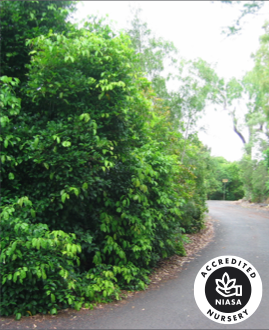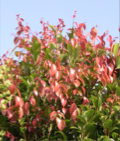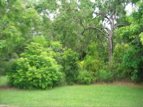Local North Queensland information for Local North Queenslanders.
So you want to screen out your neighbours and cut out the traffic noise…
 You could build a fence 2 metres high, but how sterile and hot is that? Much better to plant a screen of native plants to filter and cool the air, produce flowers, attract birds and butterflies and create a lovely shady feel to your garden.
You could build a fence 2 metres high, but how sterile and hot is that? Much better to plant a screen of native plants to filter and cool the air, produce flowers, attract birds and butterflies and create a lovely shady feel to your garden.
Here’s what NOT to do!
DON’T select a particular variety and plant a monoculture of the same thing! Why not? For a start, they won’t all grow the same. Some will grow well, others will be ordinary, and invariably there will be a couple of runts which hardly grow at all. So, your nice even row of plants will be anything but even, and the uneven-ness will stand out like a sore thumb.
DON’T plant your plants in individual holes. The last thing you want to do is spend your week-end mowing between all the plants along your fence line.
On small suburban blocks you probably won’t have room for more than one row of plants. However, on a larger block, DON’T plant a single row unless your space is too narrow for anything more, since it is easy to see straight through the gaps between the plants, and you may not have achieved the privacy you set out for.

So, here’s what you SHOULD do!
- Thorough soil preparation is the key to good plant growth, so dig up the whole bed.
- Choose a mixture of different plants with a variety of foliage shapes, sizes and colours.
- Where space allows, plant at least two rows of plants and (on larger blocks) better still three. Stagger the plants in the rows.
This way, you will create a lovely thick bushy screen with so much visual appeal that people will look AT the plants rather than THROUGH them. No-one will see you on the other side. And if a couple of plants don’t grow quite as well as the others, no-one will notice because, hey, they’re all different anyway!

How many plants do you need?
To calculate the number of plants you will need, a good rule of thumb is to work on a spacing of 1.5m to 2m apart. Don’t go closer than 1.5m, as the plants will fight each other for space and become thin and lanky. Don’t go further than 2m apart or the plants will take too long to meet up and create a screen.
Do you have a large block or acreage?

Make your screen at least 2 (and preferably 3) rows wide. The following additional plants make great screens and windbreaks for large blocks:
- Syzygium: tierneyanum
- Syzygium bamagense
- Cryptocarya triplinervis
- Chionanthus ramiflorus
- Casuarina cunninghamiana

Here’s some good screen plants for a normal suburban yard (heights are a general guide only, as height varies according to micro-climate and soil):
Some screen plants for a tropical look:
|
|
Honeyflora screen plants:
|
|
||
|
|||


